2013年2月27日 星期三
常識工作- 火車票演變
九廣鐵路於電氣化後發行之車票研究與分析























九廣鐵路於1978 年開始進行現代化工程,當中包括全線雙軌化、購置新列車、月台重組、裝置機電設備、售票機、出入閘機及更新票務系統。而由於地鐵比九鐵更早開始使用磁性車票,因此九鐵曾參考地鐵車票之設計作藍本,並曾以 1981 年發行的小童 / 學童儲值車票作試驗。

地鐵小童 / 學童儲值票 (九鐵試驗版)
1982 年 2 月九鐵印制了第一款紙車票,此款紙車票於當時用作各種單程及來回車票,而因為這種車票使用時間短 (約為一年,其後九廣鐵路脫離政府成為九廣鐵路公司) 且現存數量不多,品相良好的車票價錢可達到 $100 以上。九廣鐵路脫離政府後,成為九廣鐵路公司,車票上的公司名稱亦同時更改了,1990 年,九鐵再次更改車票上的公司名稱及標誌,而兩款車票之內容均大致相同。



「九廣鐵路局」 / 九廣鐵路公司 (舊標誌) K.C.R.C / (舊標誌) KCRC
1993年 7 月,九鐵首次引進塑膠車票取代部份紙車票,以響應環境保護及提高其可靠性,此後紙車票只用作各站往羅湖、馬場及頭等車票之用,而紙車票上的資料亦相應作出簡化。



九鐵首次引進的塑膠車票及紙車票 (1993/07/01)
至同年10月1日,羅湖成人單程及來回票亦開始使用塑膠車票,而紙車票只用作各站來往馬場、頭等、優惠羅湖單程及來回票。此套車票之抗磁性亦相對地比其他單程票強。


九鐵羅湖成人單程及來回票 (塑膠版 - 1993/07/01)
1997年 5月,九鐵更換新公司標誌,而車票上的標誌亦同時作出更新,但舊款車票亦繼續使用。 1999年,東鐵列車進行翻新工程,車票上的列車亦由第一代列車 「翻新」為第二代列車。










1997年 5月至1999年的車票,隨着列車翻新工程的進行,票面上的列車亦由第一代 「翻新」為第二代。
隨著2003年西鐵通車,九鐵亦在此時統一票務系統,由十多種 (包括紙車票及塑膠車票),簡化至四種 (成人、優惠、成人頭等及優惠頭等),並一直沿用至合併前。




世紀列車車票,此亦為兩鐵合併前九鐵最後一套單程票。


1997年9月,八達通系統正式面世,邁進令香港人生活更輕鬆的第一步。此嶄新系統讓乘客一卡在手,通用於多種公共交通工具,免除使用輔幣之不便。
2000年4月,八達通獲香港金融管理局簽發「接受存款公司」牌照,讓八達通業務得以擴展到更多不同種類的應用範疇,尤其是零售業。電子貨幣發展展開新的一頁。
2013年2月20日 星期三
2013年2月18日 星期一
The Cello of Mr. O - extended reading
Bach
The music of Bach is mentioned in the story. Johann Sebastian Back was born in
Germany on March 21, 1685. He came from a family of musicians. Over 300
years of Bachs all worked as musicians! During his lifetime, Bach had three major
jobs: he worked for a duke, he worked for a prince, and he became the director
of music at the St. Thomas Church and School in Leipzig, Germany. His music
did not make him famous until 100 years after his death. Although Bach may be
famous for his music, there is something else that made him famous during his
lifetime: his twenty children! Five of the boys were named Johann and two of
the girls were named Johanna! A few of his children grew up to be composers
themselves. Bach died on July 28, 1750. Probably the best way to experience
Bach is to listen to his music. Pick up some of his music at the library for your
student to listen to. Does he/she recognize some of the songs?
The music of Bach is mentioned in the story. Johann Sebastian Back was born in
Germany on March 21, 1685. He came from a family of musicians. Over 300
years of Bachs all worked as musicians! During his lifetime, Bach had three major
jobs: he worked for a duke, he worked for a prince, and he became the director
of music at the St. Thomas Church and School in Leipzig, Germany. His music
did not make him famous until 100 years after his death. Although Bach may be
famous for his music, there is something else that made him famous during his
lifetime: his twenty children! Five of the boys were named Johann and two of
the girls were named Johanna! A few of his children grew up to be composers
themselves. Bach died on July 28, 1750. Probably the best way to experience
Bach is to listen to his music. Pick up some of his music at the library for your
student to listen to. Does he/she recognize some of the songs?
巴哈《第五號c小調無伴奏大提琴組曲》
The Red Cross
Notice the relief truck is from the Red Cross. The Red Cross was the inspiration
of Henry Dunant, a Swiss man. During a trip to Italy in 1859, Dunant witnessed
the Battle of Solferino. He was horrified to see the aftermath of the battle and
that there was no aid for those that had fallen. He organized the women and
the children of the area to provide aid to those injured soldiers. After returning
from Italy, he wrote A Memory of Solferino, which described his experiences. He
later went on to help create the organization of the Red Cross, whose main
objectives were to bring aid to the sick and wounded regardless of their
nationality. The international symbol of the Red Cross is a white background
with a red cross. This symbol was taken from the flag of Switzerland, Henry
Dunant’s birthplace. It is basically the reverse of the Swiss flag. The Swiss flag is
a red background with a white cross. Have your student find Switzerland on a
map.
Clara Barton
The relief truck comes every week. What organization runs the relief
trucks? The Red Cross (see above lesson for more information). This might be a
good time to learn more about the founder of the American Red Cross. Clarissa
Harlowe Barton (who always wanted to be called Clara) was born on Christmas
Day in 1821. She was educated at home. During the Civil War, Clara risked her
life to bring supplies and support to soldiers out on the battlefield. She
eventually earned the nickname, “Angel of the Battlefield” for her efforts during
the war. After the war, she was involved in searching for missing
persons/prisoners from the war. She also set up a national cemetery for the
Union prisoners of the Andersonville Prison in Georgia. She then went on to
start the American Red Cross and run it for 23 years. She died on April 12, 1912.
The Cello of Mr. O 歐先生的大提琴
 這是一篇在戰火中音樂發揮撫慰人心作用的感人故事。父親被徵召,恐怖的爆炸火光,到處都是斷垣殘壁,排隊領配給,讓小女孩無時無刻不憤怒、恐懼害怕。歐先生,一位公認冷漠且避之唯恐不及的孤僻的老人,在炮彈的威脅中,依然公開演奏,展現了勇氣、智慧和驕傲,也安撫鄰居不安的心靈。
這是一篇在戰火中音樂發揮撫慰人心作用的感人故事。父親被徵召,恐怖的爆炸火光,到處都是斷垣殘壁,排隊領配給,讓小女孩無時無刻不憤怒、恐懼害怕。歐先生,一位公認冷漠且避之唯恐不及的孤僻的老人,在炮彈的威脅中,依然公開演奏,展現了勇氣、智慧和驕傲,也安撫鄰居不安的心靈。
書中提及小女孩在戰火中看到迫擊砲時假裝自己看到流星和隕石,因此在工作紙上加入這個項目。
另外書中作者用 歐先生的大提琴的身世去同戰爭作對比,因此要加入地理資料:
『“那是一把了不起的大提琴,琴面和琴背是用德國白影楓木做的,還要用法國生產的專用上光劑手工打磨出光澤。”爸爸說,“琴頸用的是洪都拉斯的桃花心木,指板用的黑檀木大概是斯里蘭卡出產的。”
“大提琴的弓,是用一種巴西軟木做的,一頭還嵌著非洲象牙。”爸爸繼續說,“全世界的人共同合作,才能製作出歐先生的大提琴。”』
2013年2月16日 星期六
訂閱:
文章 (Atom)


























